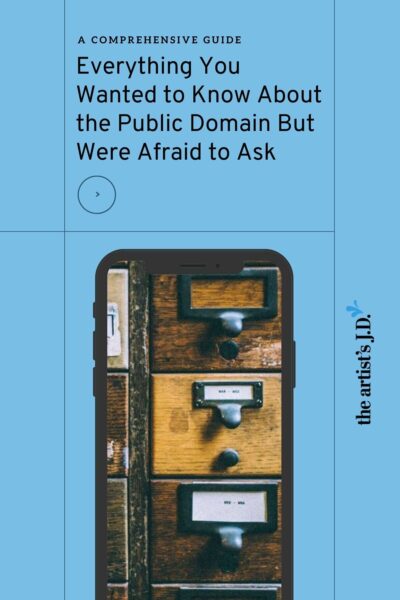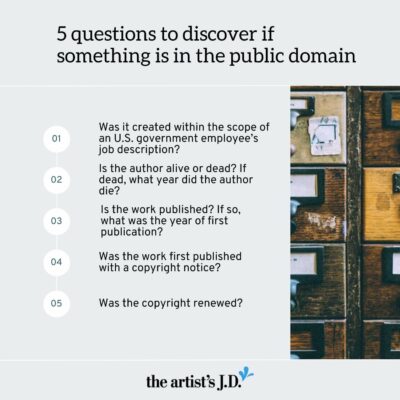Last Updated: January 9, 2025
In this guide, you’ll find a strategy to discover if a work you want to use is in the public domain. You’ll also learn how to decide what creations are in the public domain, and what you can do with public domain creations.
But before we begin, let me share what this post is not.
It’s not an intimidating resource with complex terms and legal jargon.
It’s not a “theory” post filled with abstract ideas you’ll need to figure out.
I’m going to cover the most basic parts of public domain content and show you how to decide if something is in the public domain (and free to use) or not.
Keep on reading, or jump ahead to the section that interests you most.
What is the public domain?
The short version is the public domain contains creations eligible for copyright but these creations are no longer protected by copyright.
If something is in the public domain you can use, modify, adapt, change, or build upon the original without asking permission.
Creations in the public domain are free for creators to do as they please.
This is in contrast with work still protected by copyright, where you must get permission before using it (or your use must qualify as fair use).
So the real heart of this post is helping you understand how to determine if a work you want to use is still protected by copyright or if it’s in the public domain.
And this guide will help you do just that. After reading it, you will have a strategy to determine if a specific work is in the public domain and free for you to use as you please.
We’ll also cover everything else you may want to know about the public domain, including a brief history of copyright and how it’s gotten longer over the years.
This is a deep dive into the public domain you can refer to again and again, and I’ll be updating regularly so you have the latest details.
If you’ve been dreaming of adapting a specific work (without getting a scary lawyer letter) and wondering what it entails, read on.
First, who should care about the public domain?

Any creative that wants to incorporate another’s work into their creations should understand how and when works enter the public domain.
Say you want to take Sherlock Holmes and use it in your work.
If Sherlock Holmes is still protected by copyright, then you’ll either need to:
- get permission to use it
- use it in a way that equals fair use
But using it in a way that equals fair use severely restricts what you can do with it.
If you wanted to create a parody, then you might be able to rely on fair use.
If you wanted to use a very small part to illustrate a larger point, then you might be able to rely on fair use.
If you are creating social commentary, then you might be able to rely on fair use.
But what if you wanted to:
- write a modern adaptation set in 2025 London?
- write a futuristic version set in 3019 London?
- release the original text with your illustrations?
- create a children’s book version?
- turn it into a play/movie?
- take the original and create a graphic novel?
If you want to do any of these things, then you’ll need to make sure that Sherlock Holmes is in the public domain. (Or get permission from the Sir Arthur Conan Doyle Estate.)
Works in the public domain are free for creatives to use, build on, transform, or perform.
What is in the public domain?
There are three common ways that work enters into the public domain:
- copyright expires
- copyright never perfected
- work was never protected by copyright
In the public domain because the copyright has expired
The U.S. Constitution gives creators the exclusive right to monetize their work for a limited time.
But what qualifies as a “limited time” has gotten longer and longer.
In 1790 when the first Copyright Act was passed this “limited time” was 14 years. If the creator was still alive at the end of those 14 years, he/she could renew the copyright for another 14 years.
Meaning the “limited time” was no more than 28 years.
For works created now, this “limited time” is much longer. Now it is 70 years after the death of the author. (Or for some works 95 years from first publication or 120 years from creation.)
Which at minimum is more than twice as long as the original cap.
Current copyright lengths
As I mentioned above, currently there’s no one set copyright term.
Thanks to changes over the years, there are four possible copyright terms for works protected by copyright.
These four options are:
- 95 years from first publication
- 120 years from creation
- The longer of the creator’s life plus 70 years OR December 31, 2047
- Life of the creator plus 70 years
What can no longer be protected by copyright and is in the public domain
After the copyright term expires, work falls into the public domain.
If it was first published in the United States before January 1, 1930, it’s no longer protected by copyright. (Because no matter which term applies, it will have expired.)
This means everything first published before January 1, 1930, is now in the public domain.
In the public domain because the copyright was never perfected
Since 1989, copyright notice has been optional in the United States.
Before that, a copyright notice on the work was a requirement to make the copyright valid.
If a work was first published before 1989 without notice, it is in the public domain because the copyright was never valid.
(Note: There was a small window where creators could “fix” this. To fix it, the work had to be registered with the U.S. Copyright Office within five years.)
In the public domain because it was never protected by copyright
Of course, many creations aren’t eligible for copyright protection and aren’t protected by copyright.
Works created by the U.S. Government (and its employees) aren’t protected by copyright.
So even if it’s eligible for copyright, if it’s created within the scope of a government employee’s day-to-day duties it’s not protected by copyright.
For example, Randy Bresnik has taken jaw-dropping photos of the Earth from the International Space Station.
But he’s taking those photographs as part of his duties as an astronaut. And as an astronaut, he’s a U.S. Government employee. Because he’s a government employee and taking photos is part of his job, the photos are automatically in the public domain.
What isn’t in the public domain
Contrary to popular belief, doing any of these things does not put the work in the public domain:
- Putting work online
- Using a Creative Commons license (unless the rarely used PDM license is selected
- Finding content online and not being able to trace it back to the original creator because it hasn’t been properly credited/linked
Instead, you should assume that something is protected by copyright unless you discover otherwise.
The history of the public domain
From 1998 to 2019, the number of works in the public domain was stagnant.
Why? Well, thanks to Mickey Mouse.
In 1998, Steamboat Willie was less than 10 years from entering the public domain.
And Disney wasn’t pleased.
Disney is one of the loudest voices and pocketbooks fighting for longer copyrights.
And in 1998, their lobbying paid off. Because Congress passed a law adding 20 years to all copyright terms.
This new law hit a pause on works entering the public domain.
In 1998, works first published in 1922 were released in the public domain.
But the pause button meant that works first published in 1923 wouldn’t be released into the public domain until 2019.
So for 21 years, the number of works in the public domain was exactly the same.
Luckily for creatives, on January 1, 2019, we hit the play button again.
As of January 1, 2025, all works first published in 1929 are in the public domain.
And now hundreds of thousands of new books, music, paintings, poems, films, and photographs are in the public domain.
Some of these include:
- Popeye the Sailor Man
- A Farewell to Arms by Ernest Hemingway
- Edward Hopper’s Chop Suey
- Rhapsody in Blue by George Gershwin
And thanks to sites like Google, within a few days we’ll likely get access to digital copies of these works.
Meaning almost instantly you can start using, performing, adapting, and building upon them.
As of now, there’s no pending legislation that will hit the pause button again.
So, this process should be repeated each January 1st until 2073. (Because the copyright term is tied to the year of publication, not the exact day of first publication.)
After January 1, 2073, the process will continue, but will no longer be based on first publication. Instead, works will enter the public domain 70 years after the year the author died.
How to know if something is in the public domain
As you glance at the chart on the right, you’ll realize how difficult it can be to decide if something is in the public domain.

Because it’s difficult, over the last several years there have been high-profile court cases that have “placed” work in the public domain. These include deciding that Happy Birthday to You, Sherlock Holmes, and Who’s on First all had “fallen” into the public domain.
Of course, you don’t want to do that. So is there a process you can use to determine if it’s likely that the work is in the public domain?
Yes!
The public domain rules
You are going to start with the premise that the work is protected by copyright.
And you’ll only change your answer if you can verify that it’s fallen into the public domain through your research.
For your research, you’ll need to answer five questions. Two of these questions are about the creator of the work. And three are about the work itself.
Questions about the creator
- Was it created within the scope of a U.S. government employee’s job description?
- Is the author alive or dead? If dead, what year did the author die?
Was it created within the scope of a U.S. government employee’s job description?
As discussed above, if something is created within the scope of a U.S. Government employee’s job description, then it’s automatically in the public domain.
Examples of this include:
- astronaut photographers
- WPA and FSA photographers (including photos taken by Walker Evans, Dorothea Lange, and Gordon Parks)
- laws
- government reports (like a census)
- federal court decisions
Is the author alive or dead? If dead, what year did the author die?
If the work hasn’t been published and the author died before 1954, then the work is now in the public domain.
Questions about the work
- Is the work published? If so, what was the year of first publication?
- Was the work first published with a copyright notice?
- Was the copyright renewed?
Is the work published? If so, what was the year of first publication?
Until 2073, works entering the public domain will be tied to the year of first publication.
So to determine if something is in the public domain you must learn the year of first publication. Anything first published in the United States before January 1, 1930, is in the public domain.
Was the work first published with a copyright notice?
For all works first published before February 28, 1989, a copyright notice was required.
So to determine if something is in the public domain, you must first learn the year of first publication. And then if it was published before 1989, learn if it was published with a copyright notice.
- If it wasn’t and the work was published in or before 1977, then the work has fallen into the public domain.
- If it wasn’t and the work was published between 1978 and 1989, then this could be “fixed”. To “fix” it, the work had to be registered with the U.S. Copyright Office within five years of publication. If it wasn’t registered, then the work has fallen into the public domain.
Was the copyright renewed?
Before 1978, the copyright system involved renewing your copyright. So there’s a small window (from 1929 to 1963) where this “old” system still applies.
If a work was published between 1929 and 1963 with a copyright notice and was registered, then it’s still protected if the copyright was renewed. If it wasn’t the work has fallen into the public domain.

A couple of notes:
- Publication is the year of first publication
- This chart is for works first published in the United States or works created by U.S. residents or people living in the United States at the time of creation.
- There are different rules for sound recordings and architectural drawings, so don’t rely on the chart above for those items, instead use this Cornell resource for sound recordings and architectural drawings.
- The copyright term runs through the end of the calendar year, it doesn’t expire on the anniversary of first publication or the creator’s death.
- A great way to find some of the answers to these questions is the Copyright Office’s Copyright Records Portal.
So to determine if a work is in the public domain, you’ll:
- Search the internet (because there’s no need to research the answer to these 5 questions if someone else has done it for you!)
- If you can’t find out if the work is in the public domain from a reputable online resource, then you’ll answer each of these 5 questions for the work. (Again the Copyright Office’s Copyright Records Portal can be a great resource to search.)
Key takeaways
The main thing to remember is it is best to assume work is still protected by copyright unless you can prove that it’s not.
We also learned that:
- Works first published before 1930 are now in the public domain
- Works created by government employees automatically enter the public domain
- Works first published without a copyright notice might be in the public domain
Do you still have questions?
No shame in that! One of the perks of membership in the artist’s Courtyard is a 24/7 private online community to ask your questions and get my answer (and insights from other creatives). Already a member? Ask your question! Not a member yet? Join us inside the artist’s Courtyard for $45/month!

Hi! I’m Kiff! I’m your friendly legal eagle (and licensed attorney).
My goal is to add ease to the legalese. And because I think basic legal resources should be available to every creative, I create a lot of free content.
If I’ve created something that has helped inject a little ease into your creative business and you would like to say “thank you”, you can make a contribution here.
If you’d like to hear more from me, I’d love to pop into your inbox every Friday morning to share additional ways to cut through the red tape and inject a little ease.
Get tips from your friendly legal eagle in your inbox…
Your privacy is important to us. Learn how we protect it here.

